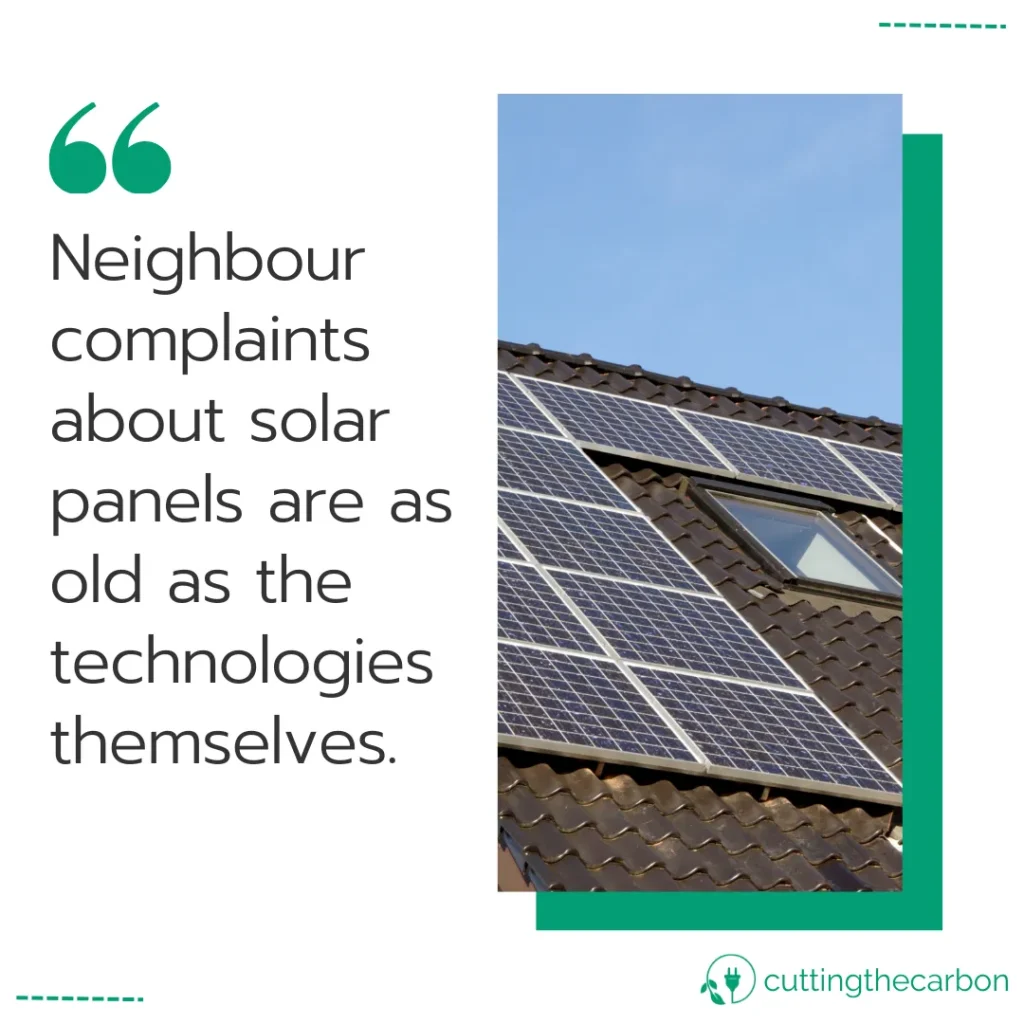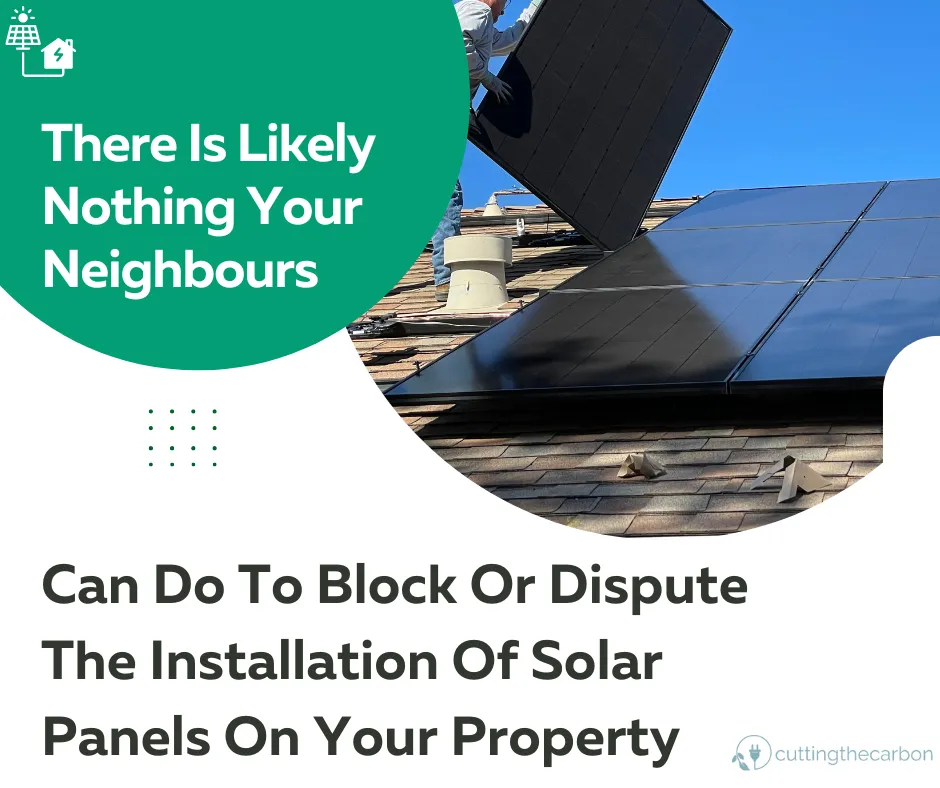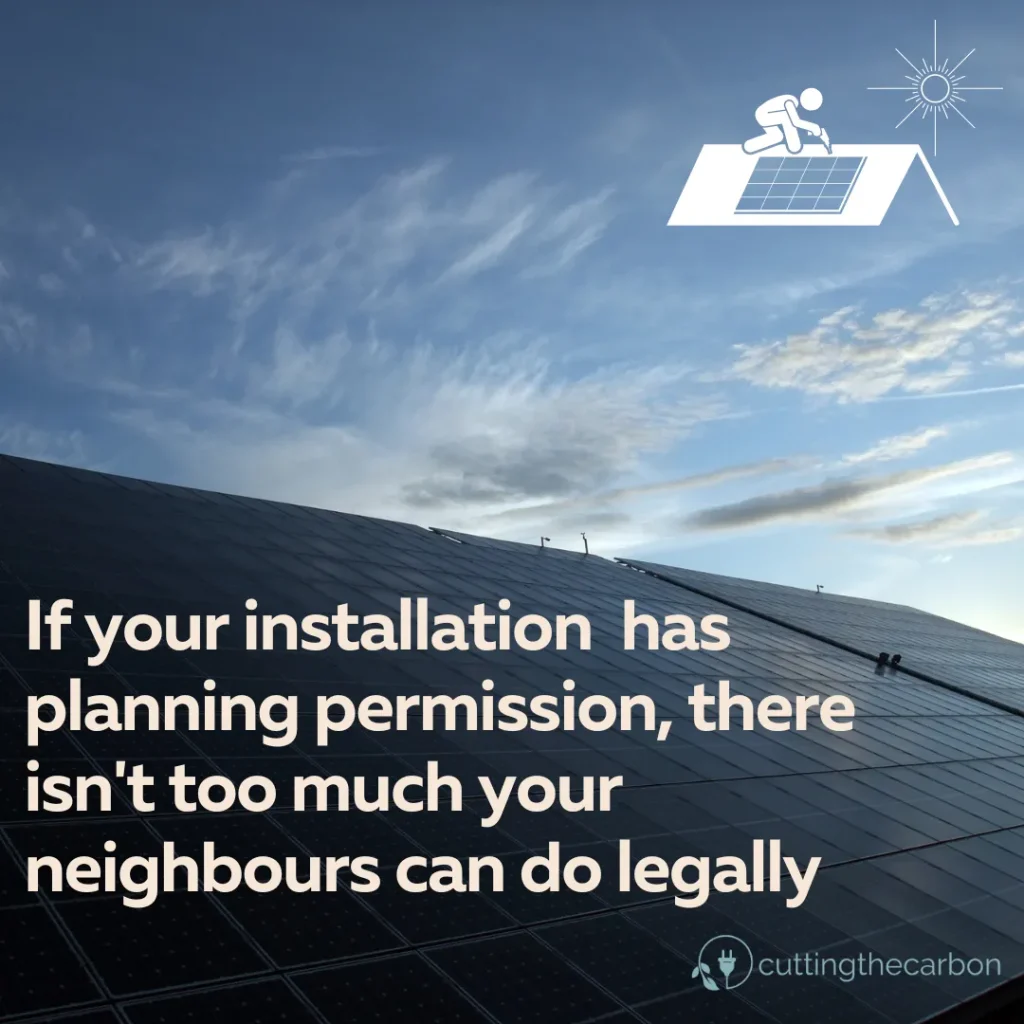Can neighbours complain about solar panels? It’s a question that often arises when homeowners decide to go green.
Navigating the complexities of renewable energy installations can be tricky, especially when it comes to keeping neighbourly peace. Solar panels, while beneficial for the environment and your wallet, can sometimes stir up controversy in residential areas.
This is why understanding whether neighbours can complain about solar panels and how to handle such situations effectively becomes crucial.

Understanding Solar Panels and Neighbour Complaints
The dawn of solar panels has brought about a shift in the way we source energy. Nonetheless, its reception has been far from plain sailing. One common issue that surfaces when installing these renewable systems is neighbour complaints.
In essence, issues such as visual impact and potential glare caused by the panels are frequently raised by neighbours who don’t fully understand renewables.
Solar Panel Arrays: Efficiency vs Aesthetics
Solar panel arrays prioritise efficiency over aesthetics, sometimes resulting in installations that may not blend with existing architectural styles or natural views. This clash can be a significant concern for those who value their property’s appearance.
Potential glare from solar panels also contributes to neighbourhood contention. Although minimal with modern-day units, glare can sometimes be an issue.
Solar Panel Issues For Neighbours Video Explanation
The Importance of Proper Planning in Installing Solar Panels
Just as wind turbines and solar panels both have their own advantages, they also bring along certain difficulties. One such challenge for solar panel installation is the necessity of thorough planning.
If you want to avoid stumbling blocks that could halt your momentum towards renewable energy use, here are some key steps when installing a new solar PV system.
Consulting Local Authorities Before Installation
You must consult with your local planning department to navigate potential roadblocks like local regulations or building codes. This step can help ensure compliance and prevent any unpleasant surprises.
An improperly planned installation may lead to removal orders from authorities – an expensive mistake no homeowner wants on their journey towards sustainable living. Consulting professionals early will save both time and money in the long run.

Communicating With Neighbours Before Installation
Avoiding neighbour complaints about things like glare or visual impact starts by opening lines of communication before beginning work on your project.
A proactive approach allows neighbours’ concerns to be heard and addressed beforehand, often leading to them being more supportive throughout the process.
- Talk openly about why you’re choosing renewables: whether it’s environmental consciousness or financial savings.
- Discuss how siting solar panels correctly reduces aesthetic issues without sacrificing efficiency.
Criteria for Solar Panel Set-Up
Certain guidelines should be met to qualify as an accepted set-up for solar panels.
The following stipulations apply:
- Solar panels should extend no more than 200mm from the roof’s surface or exceed 1m above the tallest portion of the roof, chimneys not included.
- Solar panels are permitted only if a roof overlooks a highway’s angle of at least 45 degrees from a flat position.
- For roofs facing a conservation area, panels should either be level with the roof or seamlessly incorporated into the roof’s structure.
- Panels shouldn’t be mounted on listed buildings unless they align with or are integrated into the roofing.
Meeting these criteria ensures that neighbours have no basis for complaints. On the other hand, deviations from these specifications could give neighbours justifiable concerns.
Dealing With Potential Glare From Solar Panels
Solar panels, while a brilliant green solution, can sometimes cause friction between neighbours. One common neighbour complaint concerns the potential glare solar PV systems might produce.
Understanding how to manage and mitigate such issues becomes vital for maintaining good relations with neighbours who may not fully understand renewables yet. A comprehensive glare assessment before installing solar panels could be just what you need.
How Solar Tracking Systems Work
A dual-axis solar tracking system offers an innovative way of dealing with possible glare from your proposed installation. These systems adjust the panel’s angle daily in sync with the sun’s movement across the sky – much like how wind turbines work but without noise disturbance.
The dynamic nature of these tracking systems ensures optimal exposure to sunlight while reducing reflections at certain times, which might otherwise lead to complaints about visual discomfort or inconvenience.
It’s worth noting that this advanced approach is more costly than static installations due to its complexity.
The Role Of Anti-Glare Panels
If you’re looking for another option for managing light reflection off your renewable system, anti-glare panels should pique your interest.
Designed specifically to diffuse incoming light and prevent direct outward reflections, they significantly reduce disturbances caused by traditional photovoltaic modules.
In essence, anti-glare coated solutions are proving themselves as crucial players driving wider acceptance towards clean energy sources like domestic turbines within our communities – all while keeping peace among those living near one another.
Aesthetics and Siting Solar Panels
When it comes to installing solar panels, one of the most common neighbour complaints revolves around aesthetics.
In essence, striking the right balance between efficiency and aesthetics during installation is key to harnessing maximum sunlight and maintaining harmony with your neighbours.
Balancing Efficiency and Aesthetics
The siting of your solar panel arrays requires careful consideration.
Here are some suggestions:
- Solar panels should ideally be installed at an angle that optimises exposure to sunlight while minimising visibility from neighbouring properties (solar tracking systems work effectively here).
- Consider ground-mounted installations hidden behind landscaping features or integrated into existing structures like garages or pergolas.
- Select colour options for your panels which blend well with surrounding architecture without compromising performance.

Navigating Legal Considerations Around Solar Installations
Navigating the legal considerations for solar installations in the United Kingdom requires at least some understanding of planning permissions and building regulations.
While many solar installations are treated as “permitted developments” and don’t need a planning application, there are exceptions, especially in designated areas like conservation zones or listed buildings.
It’s also good to be aware of the stipulations regarding the size and position of the panels, as they might affect the overall aesthetic of an area or infringe on neighbours’ rights.
Engaging with local councils and seeking expert advice can help streamline the process and ensure full legal compliance.
Wind Turbines Vs Solar Panels: Comparing Renewable Options
The debate between wind turbines and solar panels continues to rage in the renewable energy sector. Both have pros and cons, yet they come with some negative aspects.
Solar panels are silent power generators harnessing sunlight’s potential for electricity production. Installing solar panels on rooftops or open fields makes them a great choice for those who value peace and quiet.
An Overview of Wind Power
On the other hand, we’ve got wind turbines which convert kinetic air energy into electrical power. Unlike large-scale models, domestic versions are designed to minimise visual blight and noise disturbances due to strict height restrictions imposed by local regulations.
This does not mean they are entirely free from neighbour complaints, though – some may still find these structures visually unappealing or mildly noisy during operation.
A Look at Solar PV Systems
Moving back towards solar panel arrays, yes, higher initial costs might be involved when installing a small-scale turbine system – factors such as the quality of equipment used and complexity associated with the installation process contribute here significantly.
But remember: once up and running, these systems require minimal maintenance while offering steady returns despite weather-dependent efficiency levels.
While both wind turbines and solar panels offer sustainable energy solutions, they come with their own pros and cons. Solar panels are silent, but may incur higher initial costs; while wind turbines can be visually unappealing or mildly noisy to some neighbours. Weigh up your options carefully before choosing the green technology that suits you best.
FAQs Concerning Can Neighbours Complain About Solar Panels
Do I need Neighbours permission for solar panels?
In the UK, you generally don’t require neighbours’ consent to install solar panels. However, it’s good practice to inform them about your plans.
Do solar panels cause glare for neighbours?
Solar panels can potentially cause glare depending on their angle and sun position. Proper planning and anti-glare solutions can mitigate this issue.
What are the rules for solar panels UK?
The installation of domestic solar PV systems in the UK is subject to building regulations and may require planning permissions under certain circumstances.
What regulations apply to solar panels?
Solar panel installations must comply with local building regulations, electrical safety standards, fire safety requirements and any relevant planning permissions or restrictions.
Conclusion
Installing solar panels can spark some neighbourly disputes. Realising the complexities of the situation is essential. Proper planning and communication with neighbours before installation are important to prevent future complaints.
The potential glare from solar panels can be mitigated using anti-glare panels or a dual-axis tracking system that adjusts the panel’s angle throughout the day.
Aesthetics also play a role in siting your solar array; balancing efficiency and aesthetics may help keep peace with those who find renewable energy systems unsightly.
Navigating legal considerations around installations could provide further protection for homeowners wishing to go green.
If you’re ready to embrace renewable energy but concerned about how your neighbours might react, Cuttingthecarbon will guide you through every step.
We’ll ensure that you get an efficient setup tailored to your needs and advise on how best to address any concerns raised by those living nearby.

